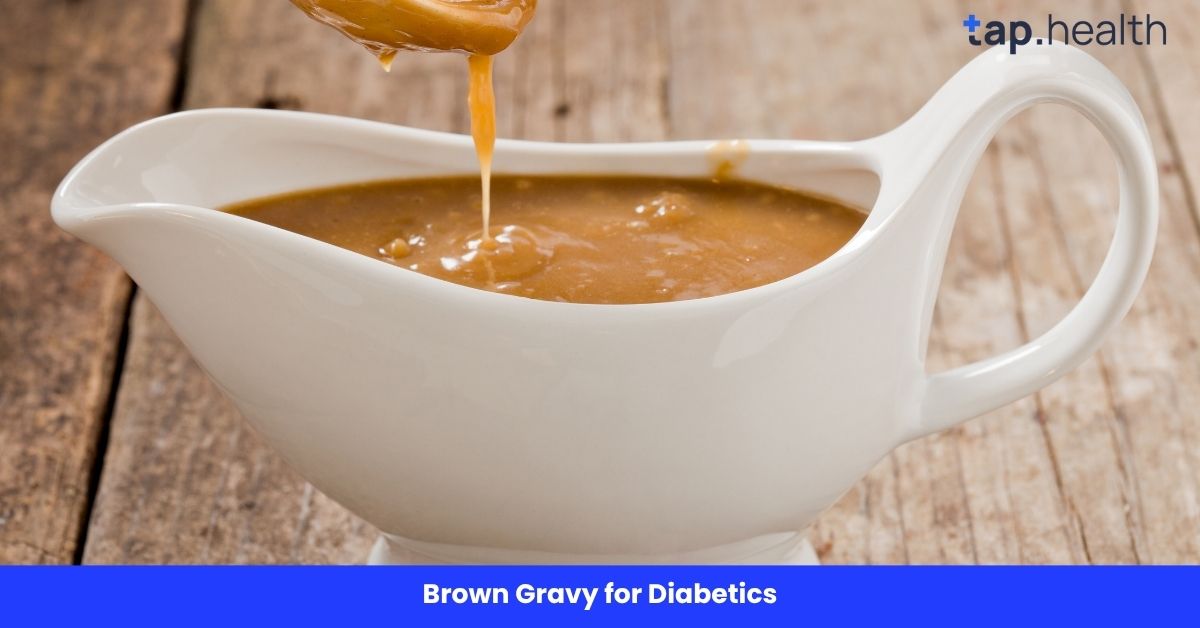Gravy is a beloved addition to many meals, enhancing the flavor of meats, mashed potatoes, and other sides. However, for diabetics, traditional brown gravy recipes—made with high-carb ingredients like flour and cornstarch—can cause blood sugar spikes. Fortunately, there are healthier, diabetic-friendly ways to make brown gravy that are both tasty and suitable for managing blood sugar levels.
In this article, we’ll explore why traditional brown gravy may not be ideal for diabetics, provide healthy alternatives, and offer a simple step-by-step guide for making delicious diabetic-friendly brown gravy. Let’s dive into how you can enjoy rich, savory gravy without worrying about your blood sugar.
Why Traditional Brown Gravy May Not Be Ideal for Diabetics
Brown gravy is often made by thickening meat drippings or broth with ingredients like flour, cornstarch, or potato starch. While these ingredients help create the smooth, rich texture that we love, they can also spike blood sugar due to their high carbohydrate content.
Common Ingredients in Traditional Brown Gravy
- Flour: Used to create a roux, a base for thickening the gravy. Flour is a simple carbohydrate that can cause a rapid increase in blood sugar.
- Cornstarch: Another thickening agent, cornstarch is high in carbs and also contributes to blood sugar spikes.
- Sugar: Some recipes may include a pinch of sugar to balance the flavors, which can further increase the carb content.
- Butter: While butter is a fat and doesn’t affect blood sugar, it can contribute to overall calorie intake if used excessively.
For people with diabetes, consuming too many carbs or sugars in a meal can lead to unwanted blood sugar spikes, so it’s important to explore healthier alternatives to these traditional ingredients.
Diabetic-Friendly Brown Gravy Alternatives
Thankfully, there are several low-carb and diabetic-friendly substitutes that will allow you to enjoy a rich, flavorful brown gravy without spiking your blood sugar. Let’s look at some of the best alternatives.
1. Low-Carb Thickeners
Instead of flour or cornstarch, consider using low-carb thickeners that won’t affect your blood sugar.
Xanthan Gum
Xanthan gum is a natural, low-carb thickener made from fermented sugars. It’s commonly used in gluten-free recipes and works well to thicken gravies without adding carbohydrates.
- Why it’s great for diabetics: Xanthan gum has zero carbs and doesn’t affect blood sugar levels.
- How to use it: Add 1/8 to 1/4 teaspoon of xanthan gum to your broth or drippings while whisking continuously. It thickens quickly and smoothly.
Guar Gum
Guar gum, made from the guar bean, is another excellent low-carb thickening agent. It’s similar to xanthan gum but has a slightly different texture.
- Why it’s great for diabetics: Like xanthan gum, guar gum has no sugar or carbs and is a safe option for diabetics.
- How to use it: Use about 1/4 teaspoon of guar gum per cup of liquid and whisk it in slowly to prevent clumping.
Arrowroot Powder
Arrowroot powder is a natural starch that’s lower in carbohydrates than flour or cornstarch, making it a better choice for diabetics. It also has a neutral flavor, so it won’t alter the taste of your gravy.
- Why it’s great for diabetics: Arrowroot has a lower glycemic index than other starches, which means it won’t spike blood sugar as quickly.
- How to use it: Make a slurry by mixing 1 tablespoon of arrowroot powder with 2 tablespoons of cold water, then whisk it into your gravy until it thickens.
2. Low-Sodium Broth
Another key ingredient to consider when making diabetic-friendly brown gravy is the broth or stock you use. Traditional gravies may contain high-sodium store-bought broths, which can contribute to high blood pressure—a concern for many people with diabetes. Choosing low-sodium turkey broth, chicken broth, or vegetable stock can help lower your sodium intake.
- Tip: Homemade broths are ideal because they allow you to control the amount of sodium. Simmering turkey bones, vegetables, and herbs in water for a few hours will give you a rich, flavorful stock with less sodium.
3. Avoiding Added Sugar
Traditional recipes may call for a small amount of sugar to balance out the flavors, but for diabetics, this can lead to unwanted blood sugar spikes. You can easily make your brown gravy without any added sugar by opting for natural seasonings.
- Tip: If your gravy needs a bit of sweetness, try adding finely grated carrots or onions. These vegetables add natural sweetness without raising blood sugar levels.
How to Make Diabetic-Friendly Brown Gravy: Step-by-Step Recipe
Now that we’ve covered the ingredients to use and avoid, let’s walk through a simple, healthy recipe for making diabetic-friendly brown gravy.
Ingredients:
- 2 cups low-sodium turkey broth (or homemade turkey stock)
- 2 tablespoons unsalted butter or olive oil
- 1/4 teaspoon xanthan gum (or guar gum or arrowroot powder)
- 1/2 teaspoon garlic powder
- 1/2 teaspoon onion powder
- 1/4 teaspoon ground black pepper
- 1/4 teaspoon dried thyme or rosemary (optional)
- 1 tablespoon fresh parsley (optional, for garnish)
Instructions:
- Melt the Butter or Heat the Oil: In a saucepan, melt 2 tablespoons of butter over medium heat. Alternatively, you can use olive oil if you prefer a lighter fat.
- Add Broth or Stock: Pour in 2 cups of low-sodium turkey broth (or your homemade stock). Bring it to a simmer.
- Thicken the Gravy: Slowly sprinkle in 1/4 teaspoon of xanthan gum (or your choice of guar gum or arrowroot powder). Whisk continuously to prevent any clumps from forming. If you want a thicker gravy, you can add more thickener in small increments, but be cautious as too much can make it overly thick.
- Season the Gravy: Add 1/2 teaspoon of garlic powder, 1/2 teaspoon of onion powder, and 1/4 teaspoon of black pepper. Stir the mixture well to ensure the seasonings are evenly distributed. If desired, add a pinch of dried thyme or rosemary for extra flavor.
- Simmer: Let the gravy simmer for about 3-5 minutes, allowing it to thicken. If the gravy becomes too thick, simply add more broth or water to thin it out.
- Garnish and Serve: Once the gravy has reached the desired consistency, remove it from heat and garnish with fresh parsley if desired. Serve it over your favorite low-carb meal, such as roasted turkey, cauliflower mash, or steamed vegetables.
Tips for Serving Diabetic-Friendly Brown Gravy
1. Pair with Low-Carb Sides
When serving your brown gravy, opt for low-carb sides that complement your gravy without adding too many carbs. Some great options include:
- Mashed cauliflower instead of mashed potatoes
- Roasted Brussels sprouts or broccoli
- Zucchini noodles or spaghetti squash
These low-carb sides will keep your meal healthy and blood sugar-friendly.
2. Control Portion Sizes
Even though your brown gravy is low in carbs, portion control is still important. Keep your servings moderate and avoid drenching your food in gravy to maintain a healthy balance.
3. Use Whole Foods for Flavor
Instead of relying on pre-packaged seasonings, try using fresh herbs, garlic, and onions to add depth to your gravy. This helps you avoid unnecessary sugars and sodium often found in processed seasonings.
Real-Life Scenario
Imagine having a grilled chicken or vegetable meal at dinner. Adding a rich, creamy brown gravy can make the meal tastier, but store-bought gravy may contain hidden sugars or starches. By preparing a homemade version using low-sodium broth and thickening with cornstarch or whole-grain flour, you enjoy the flavor without spiking blood sugar.
Expert Contribution
Nutritionists emphasize that sauces and gravies can be “hidden sugar traps” for diabetics. They recommend checking labels for carbs, sodium, and added sugar. Homemade gravies made from fresh ingredients allow better control of calories and carbohydrate content, making them safer for blood sugar management.
Recommendations Grounded in Proven Research and Facts
- Use low-sodium broth or stock to reduce salt intake.
- Thicken with whole-grain flour or cornstarch instead of white flour.
- Avoid sugar and high-sodium additives commonly found in packaged gravies.
- Portion control matters: Stick to 2–4 tablespoons per meal.
- Pair with high-fiber foods: Fiber slows glucose absorption, helping maintain blood sugar stability.
FAQs About Brown Gravy for Diabetics
1. Can I eat brown gravy if I have diabetes?
Yes, you can eat brown gravy with diabetes by using low-carb thickening agents like xanthan gum, guar gum, or arrowroot powder. Avoid using high-carb ingredients like flour and cornstarch to keep your gravy blood sugar-friendly.
2. What is the best thickener for brown gravy for diabetics?
The best low-carb thickeners for diabetic-friendly brown gravy are xanthan gum, guar gum, and arrowroot powder. These options are low in carbs and won’t raise your blood sugar.
3. How do I make brown gravy without flour?
To make brown gravy without flour, use xanthan gum, guar gum, or arrowroot powder as thickeners. These ingredients will help you achieve the desired consistency without the carbs in flour.
4. Is brown gravy high in carbs?
Traditional brown gravy made with flour or cornstarch is high in carbs. However, by using low-carb thickeners and avoiding sugar and high-sodium broth, you can make a diabetic-friendly version that’s low in carbs.
5. How do I keep brown gravy from being too salty?
Use low-sodium broth and be cautious about adding extra salt. You can also balance the flavor with herbs like thyme, rosemary, and fresh garlic instead of salt.
Conclusion
Making diabetic-friendly brown gravy doesn’t have to be difficult. By using the right low-carb thickeners, opting for low-sodium broth, and avoiding added sugar, you can enjoy rich, flavorful gravy without worrying about blood sugar spikes. Pair your healthy gravy with low-carb sides for a complete meal that’s both satisfying and suitable for diabetes management.
With the tips and recipes provided here, you can enjoy delicious brown gravy while keeping your blood sugar levels in check. Don’t let diabetes stop you from enjoying your favorite meals—just make a few adjustments, and you’ll be able to savor every bite!



